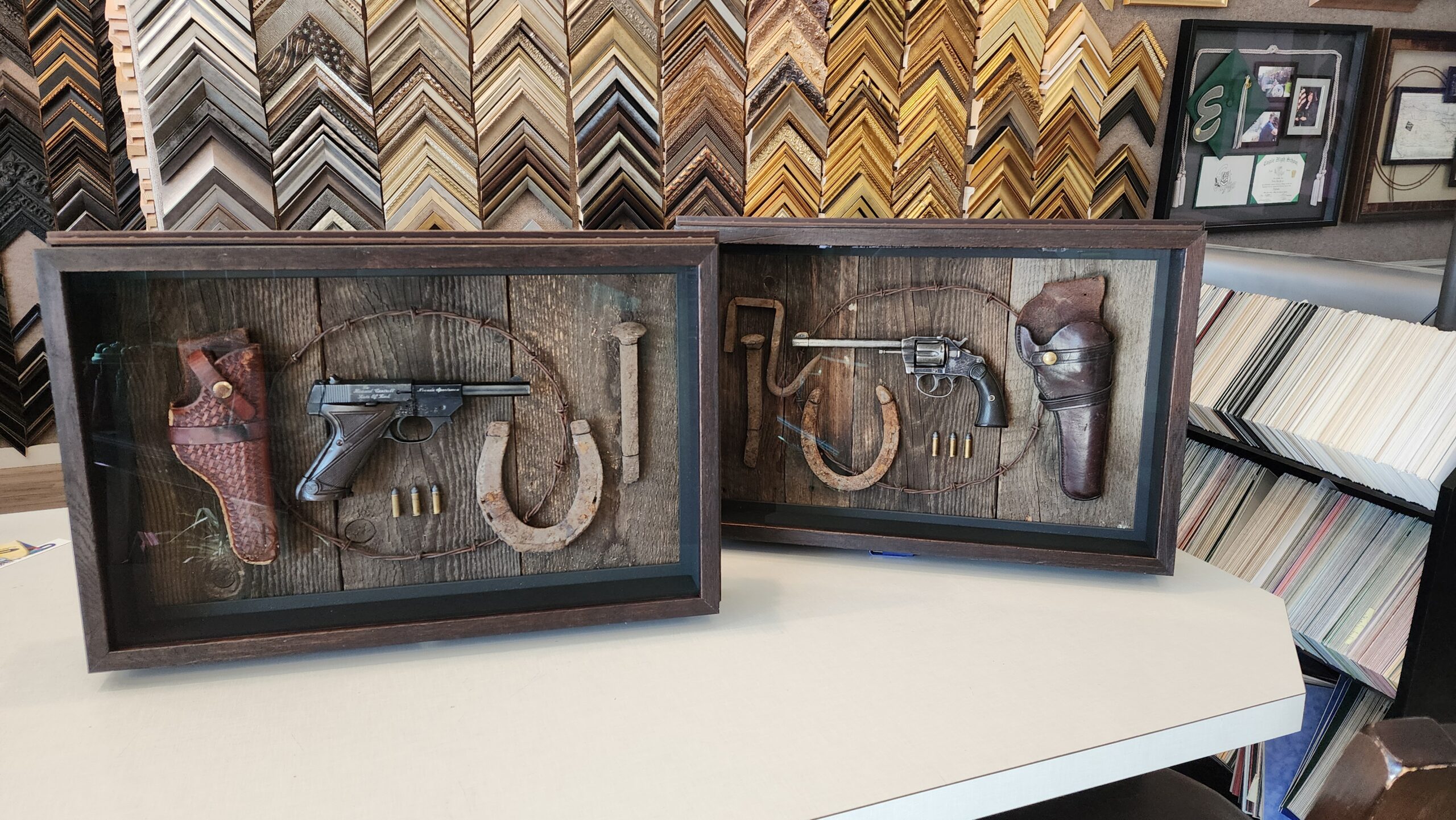By Meg Glasgow
Some framing projects go beyond design and craftsmanship—they become storytelling. That was certainly the case with these two shadowboxes I recently created for a family who had just purchased a century-old ranch in the sagebrush-covered hills of Eastern Oregon. When they walked into the shop with a weathered box of relics, they brought with them not just objects, but history—tangible pieces of the Old West.

They had recently acquired the property and were settling in when they began uncovering the past, quite literally. While cleaning out an old ranch house and outbuildings, they found everything from horseshoes and rusty barbed wire to bullets and a pair of dueling pistols hidden inside the cushions of an old sofa. To top it off, the property came complete with a rickety old gallows, a stark reminder of the rough justice that likely characterized life in this remote stretch of land more than a hundred years ago.
As they laid the items out in front of me—barbed wire coiled like a rattlesnake, dust-covered holsters, well-worn horseshoes, and a plank of timber weathered from years of sun and storms—I could feel the history in my hands. Their request was simple, yet meaningful: “We want to preserve these treasures and tell the story of the ranch through two shadowboxes. Oh—and can you use the old barn wood as part of the design?”
As much as I enjoy a challenge, I quickly realized that building frames from the actual barnwood wasn’t feasible. The boards were dry, brittle, and unpredictable—more likely to splinter than to cooperate. But I had another idea. One of my favorite mouldings, Larson-Juhl’s Axel collection, was the perfect solution. Not only did it complement the rustic theme beautifully, but it also held a personal connection for me. I had the honor of working with their design team on this collection after winning the Design Star competition in 2013. The moulding is crafted from reclaimed chestnut salvaged from old buildings in Italy—a story within a story.
I decided to preserve the barnwood for the backing, allowing it to serve as a natural canvas behind the artifacts. Its weathered texture added instant authenticity and character to the shadowboxes. The layout process was like solving a puzzle with history as my guide. I found that coiling the barbed wire created movement and energy, guiding the eye across the arrangement. The horseshoes were carefully placed with the curve facing up—a nod to cowboy tradition, where upside-down horseshoes are said to let the luck run out. The pistols, complete with their original holsters, were positioned facing each other for dramatic effect, especially when the pieces would be hung side by side.
Securing the items took patience and precision. I drilled holes through the barnwood and used wire to hold each object firmly in place. But the real challenge was depth. Between the thick barnwood and the dimensional height of the guns and holsters, I needed to build frames deep enough to accommodate everything without sacrificing visual balance. In the end, I stacked three different mouldings to create the necessary depth.
Here’s how it came together:
- Base layer: Larson-Juhl *Axel Smoked Timber 1 ½” (#384610)—a strong, stable foundation
- Middle enhancer: *Oxide Rust ¾” (#251700)—this provided a beautiful break in texture and color between the two Axel frames
- Top layer: *Axel Smoked Timber ¾” (#277610)—adding the final polish and cohesive finish
To protect the contents and ensure optimal clarity, I used Tru Vue Museum Glass. Its low-reflective surface and 99% UV protection were perfect for this project. The inside of the frame was finished with black foamcore to line the walls cleanly, giving the presentation a crisp, museum-quality finish. Late in the build, I realized I needed a thin black mat behind the barnwood to minimize the uneven surface and give it a clean edge. It worked—but I’ll admit, it made final fitting a bit trickier!
Each finished frame measures 22 inches wide by 14 inches tall. The retail value is approximately $1,500 each—an investment not just in framing, but in preserving a piece of personal and regional history.
Projects like this are what I love most about being a custom framer. It’s not just about building a beautiful frame—it’s about honoring the stories behind the objects. These shadowboxes don’t just decorate a wall; they transport you to another place and time. They carry the spirit of the Old West, the legacy of a rugged landscape, and the memories of those who lived, worked, and even hid a few pistols in the sofa cushions.
When I look at these finished pieces, I don’t just see wire and wood. I see a legacy, framed and protected for generations to come.
Leave A Comment
You must be logged in to post a comment.